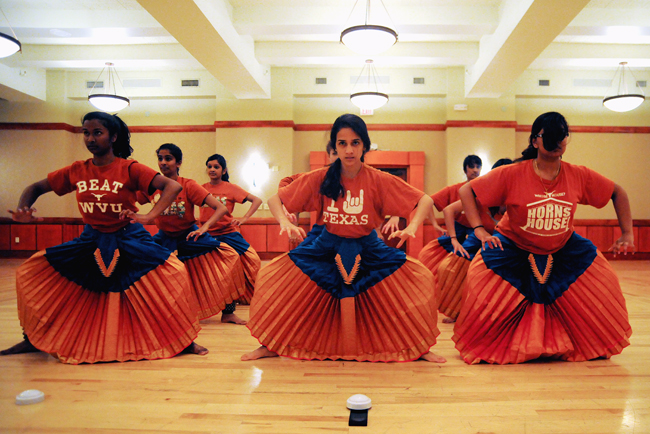Literally translated to “triumph,” “jai ho” perfectly represents the South Asian entrance into Western media. The current surge of pop culture Bollywood entertainment has thousands of Americans transfixed by vivid cultural displays from India.
UT featured the classical South Asian dance group Nritya Sangam at this year’s Gone to Texas, and nearly 12 groups on campus practice and perform Natyam, a South Asian dance.
“South Asian organizations impact the community through philanthropy, talent shows and cultural outreach. We host some of the largest events on campus designed to promote our culture,” Raj Jana, the Vice President of Student Affairs for the Indian Student Association and a founder of the UT chapter of Iota Nu Delta, explained. “We also hosted the largest talent show with nearly 2,000 guests.”
More than 1,000 students are expected to attend the annual Taal Talent Show this Saturday. Nine student groups will be competing for a grand prize of $1,000. Featuring dance and choral groups, Taal attempts to showcase different styles of South Asian performance.
“These South Asian UT teams represent a wide variety of the culture present in that region today,” Chirag Modi, a UT Indian Students Association representative, said. “We try to be unique in selecting only UT teams because we feel that the campus has a vastly diverse student body which thrives on talent.”
Unfortunately, what many students do not know is that classical Indian dance is far more than flashy moves and vibrant saris. In fact, each of the different classical styles performed around campus represents an ancient and sacred part of the Hindu religion and South Asian culture. To dancers, cultural clubs are more than just an extracurricular activity. They are also a chance to be reunited with their heritage.
“These classical styles of dance are less well known than the more common and popular Bollywood styles of dance,” Sinthuja Devarajan, a sophomore member of Nritya Sangam, said. “The average observer may see traditional styles as more boring, but in reality, these intricate moves and positions are representative of the gods, morals and values in traditional South Asian society.”
Devarajan dedicated the past 14 years to mastering the classic style of Bharatanatyam and Kuchipudi dance. She turned to dance to understand the stories of mischievous baby Krishna and the intelligence of Ganesh, two traditional Hindu deities.
Many choreographers have integrated contemporary dance moves, hip-hop remixes and the occasional dubstep interlude to cater to Western demands. These measures have drawn in spectators previously unacquainted with Indian culture. This fusion of classical and popular dance actually helps preserve the ancient art.
“The integration of Western culture makes sense because the motivation of many clubs is to get more people involved and interested in keeping our history alive,” Devarajan said.
Rupal Mehta, a member of Hum A Cappella, has combined her love of music with an opportunity to stay connected to her heritage.
“It’s unique because most cultural performing groups are dance-based, but HUM really adds something unique to UT,” Mehta said. “Dance connects us to our history and to our homeland. It’s given me a sense of my roots and my foundation.”
The choice to become involved in cultural groups, however, has drawbacks for incoming freshmen. Though students hope to stay in touch with their roots, many fear they will become too ingrained in their culture. Devarajan hopes to continue dancing but has hesitations.
“I think that there is an inevitable segregation of cultures. People gravitate toward what is comfortable,” Devarajan said. “If you can talk about your culture, your habits and your family with people who understand, then people are comfortable with that. When you’re a ‘minority’ it’s comforting to find people like yourself.”
Taal attempts to bridge the cultural divide by including music and choreography that fuses the Western and South Asian cultures. Connecting the past to the present, cultural organizations help students like Mehta and Devarajan stay in touch with their ancestry.




















